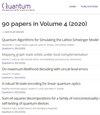Dictionary-based Block Encoding of Sparse Matrices with Low Subnormalization and Circuit Depth
IF 5.1
2区 物理与天体物理
Q1 PHYSICS, MULTIDISCIPLINARY
引用次数: 0
Abstract
Block encoding severs as an important data input model in quantum algorithms, enabling quantum computers to simulate non-unitary operators effectively. In this paper, we propose an efficient block-encoding protocol for sparse matrices based on a novel data structure, called the dictionary data structure, which classifies all non-zero elements according to their values and indices. Non-zero elements with the same values, lacking common column and row indices, belong to the same classification in our block-encoding protocol's dictionary. When compiled into the $\textit{{U(2), CNOT}}$ gate set, the protocol queries a $2^n \times 2^n$ sparse matrix with $s$ non-zero elements at a circuit depth of $\mathcal{O}(\log(ns))$, utilizing $\mathcal{O}(n^2s)$ ancillary qubits. This offers an exponential improvement in circuit depth relative to the number of system qubits, compared to existing methods [1,2] with a circuit depth of $\mathcal{O}(n)$. Moreover, in our protocol, the subnormalization, a scaled factor that influences the measurement probability of ancillary qubits, is minimized to $\sum_{l=0}^{s_0}\vert A_l\vert$, where $s_0$ denotes the number of classifications in the dictionary and $A_l$ represents the value of the $l$-th classification. Furthermore, we show that our protocol connects to linear combinations of unitaries $(LCU)$ and the sparse access input model $(SAIM)$. To demonstrate the practical utility of our approach, we provide several applications, including Laplacian matrices in graph problems and discrete differential operators.基于字典的低次归一化和电路深度稀疏矩阵分块编码
块编码是量子算法中重要的数据输入模型,使量子计算机能够有效地模拟非酉算子。本文提出了一种高效的稀疏矩阵块编码协议,该协议基于一种新的数据结构,称为字典数据结构,它根据其值和索引对所有非零元素进行分类。具有相同值的非零元素,缺乏共同的列和行索引,在块编码协议的字典中属于相同的分类。当编译成$\textit{{U(2), CNOT}}$门集时,该协议利用$\mathcal{O}(n^2s)$辅助量子位元,在电路深度$\mathcal{O}(\log(ns))$处查询具有$s$非零元素的$2^n \times 2^n$稀疏矩阵。与电路深度为$\mathcal{O}(n)$的现有方法[1,2]相比,这提供了电路深度相对于系统量子比特数量的指数级改进。此外,在我们的协议中,影响辅助量子位测量概率的缩放因子次归一化被最小化到$\sum_{l=0}^{s_0}\vert A_l\vert$,其中$s_0$表示字典中的分类数量,$A_l$表示$l$ -th分类的值。此外,我们证明了我们的协议连接到一元的线性组合$(LCU)$和稀疏访问输入模型$(SAIM)$。为了证明我们的方法的实际效用,我们提供了几个应用,包括图问题中的拉普拉斯矩阵和离散微分算子。
本文章由计算机程序翻译,如有差异,请以英文原文为准。
求助全文
约1分钟内获得全文
求助全文
来源期刊

Quantum
Physics and Astronomy-Physics and Astronomy (miscellaneous)
CiteScore
9.20
自引率
10.90%
发文量
241
审稿时长
16 weeks
期刊介绍:
Quantum is an open-access peer-reviewed journal for quantum science and related fields. Quantum is non-profit and community-run: an effort by researchers and for researchers to make science more open and publishing more transparent and efficient.
 求助内容:
求助内容: 应助结果提醒方式:
应助结果提醒方式:


